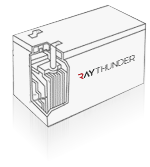Technical Manual
Construction |
+ Positive Plates are made from special lead-calcium alloy grids in which they are pasted with positive active material. + Negative Plates are made from special lead-calcium alloy grids in which they are pasted with negative active material. + Separators The super micro porous glass fiber separators in Chiway VRLA batteries have high resistance to acid .The high porosity of the separators retains adequate electrolyte for the reaction of active material. +Electrolyte Dilute sulphuric acid electrolyte is absorbed in separators and no free acid, It is a high-conductive liquid and also participates in both the discharge and recharge reaction. +Safety Vents are made of synthetic rubber with excellent acid resistance and little deterioration by aging, and release excess gas and keep the internal pressure within the optimum range of safety. +Containers and Covers are manufactured from ABS synthetic resin and retain sufficient mechanized strength to withstand battery internal pressure. +Terminals are made of copper or lead alloy depending on the battery model. Excellent terminal sealing construction and technology are given at the our VRLA batteries. |
Theory of Seal |
| PbO2+2H2SO4+PbPbSO4+2H2O+PbSO4 (Lead dioxide) (Sulphuric acid) (Spongy lead)(Lead sulphate) (Water) (Lead sulphate)Positive Electrolyte NegativePositive Electrolyte Negativeactive activeactive activematerial materialmaterial material When battery charging approaches its final stage, the charging current is consumed solely for electrolytic decomposition of water in the electrolyte. Which results in generation of oxygen gas from positive plates and hydrogen gas from negative plates, the generated gas will escape from the battery and cause a decrease of the electrolyte. Therefore occasional water replenishment is required. However, in the our VRLA Batteries, the cell is designed to promote the chemical recombination of oxygen at the negative electrode via the so-called internal oxygen cycle or oxygen-recombination cycle, i.e. At the positive electrode:At the negative electrode:H2O2H++1/2O2+2e-Pb+1/2O2+H2SO4PbSO4+H2OPbSO4+2H++2e-Pb+ H2SO4 In this cycle, by using superfine glass-fiber separator and the cathode adsorbent technology, there are about 5% air channels preliminarily reserved in the separator between anode and cathode. The oxygen generated on the positive plates in the final stage of charging will pass through the air channels to negative plates and react with sponge lead, The oxygen becomes water and returns to system, and the lead becomes lead sulfate and then returns to lead during over charging. As increasing polarization potential at the same time, the hydrogen doesn’t separate out from the negative plate. This is why our batteries can realize seal and maintenance-free. |
